Xeriscape Landscape Plants & Flowers
For The Arizona Desert Environment.
Pictures, Photos, Images, Descriptions, & Reviews.
Spanish Bayonet Yucca, Yucca aloifolia.
We Are Proud Of Our SafeSurf Rating!
Click On Any Of The Following Links By Amazon.Com
For Books, & Videos About Wildflowers Of Arizona & The Southwest USA. No Obligation!
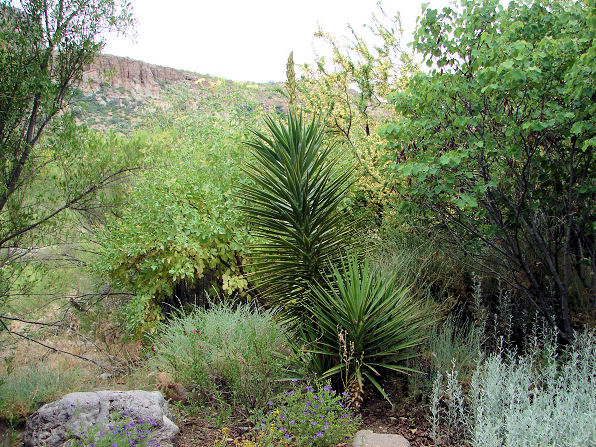 |
| Spanish Bayonet Yucca, Yucca aloifolia. Photos Taken: Boyce Thompson Arboretum. Near Superior, Arizona. May 13, 2008. |
|---|
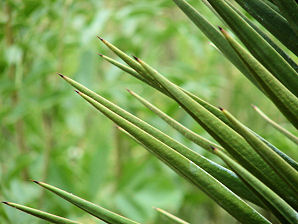 | 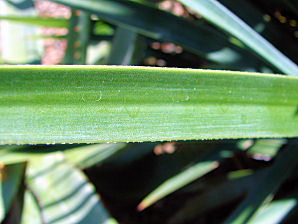 |
| Spanish Bayonet Yucca. Yucca aloifolia Spines. | Spanish Bayonet Yucca. Yucca aloifolia Leaf Margins. |
|---|---|
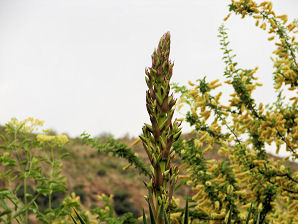 | 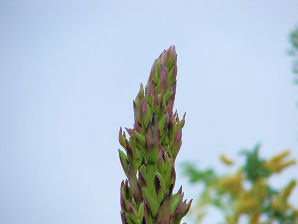 |
| Spanish Bayonet Yucca. Yucca aloifolia Flowers. | Spanish Bayonet Yucca. Yucca aloifolia Flowers. |
Spanish Bayonet Yucca.
We wish to thank Wikipedia, the free encyclopedia for some of the information on this page. We share images and information with Wikipedia. Spanish Bayonet has an erect trunk, 3 - 5 inches in diameter, reaching a height of up to 5 - 20 feet tall. When it becomes tall it has a habit of tipping over. When that happens, the growing tip turns upward and continues to grow. The trunk is armed with sharp pointed straplike leaves each about 2 feet long. The young leaves near the growing tip stand erect; older ones are reflexed downward. The tip of the trunk develops a long spike of white flowers. Spanish Bayonet also produces new buds, or offshoots, near the base of the trunk, forming a thicket around the original stalk. Do not plant Spanish bayonet near walkways, patios or in areas frequented by children and pets. This plant can inflict painful puncture wounds even through heavy clothing! This makes Spanish Bayonet the very best of "security plants." Spanish Bayonet will bloom from late summer to fall. Its flowers are creamy white, bell shaped, about 1 1/2 to 2 inches long, up to 4 inches in diameter, and they are borne on 3 - 5 foot spikes. It has excellent heat and drought tolerance and is hardy into the low teens.
Quick Notes:
Height: About 5 - 20 feet tall and 6 - 8 feet wide.
Flowers: A 3 - 5 foot long spike of white, purplish-tinged, bell shaped, flowers up to 4 inches in diameter, grow on the tip of the trunk.
Flowering Time: Phoenix Arizona, July - August.
Leaves: The leaves are dark green, 2 - 4 inch wide, 6 to 28 inches long. They have smooth leaf margins. The tips of the leaves are very pointed and sharp!
Found: Native of North Carolina to Mexico and the West Indies. It is widely cultivated and naturalized throughout much of the southern US. The USDA claims it is native of the USA (AL, FL, GA, LA, MS, NC, SC), USA+ (PR, VI).
Hardiness: Will freeze past the low 15 �F' ! However, some say that they have grown it at lower temperatures.
Soil pH requirements:
Sun Exposure:
Elevation: 0 - 2,900 feet. In Arizona.
Habitat: Coastal areas, including sand dunes, shell mounds and shorelines.
Miscellaneous: Winter Hardiness: 10 - 15� F. Photos Taken: Boyce Thompson Arboretum, Superior, Arizona. May 13, 2008.
|
We Are Proud Of Our SafeSurf Rating!
Click On Any Of The Following Links By Amazon.Com
For Books, & Videos About Wildflowers Of Arizona & The Southwest USA. No Obligation!
| © 1966 - Present, Audrey, Eve, & George DeLange |
